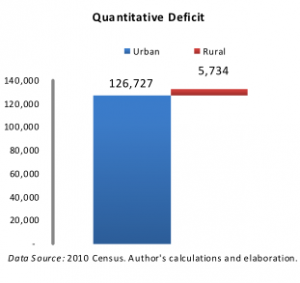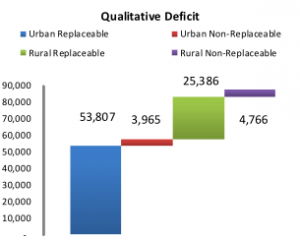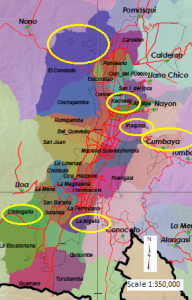THE 2013 CASLE LECTURE PRIZE
has been awarded to
Galina Alova

Galina was born in Estonia and educated in Britain. She holds an MA degree in Economics from the University of Glasgow and an MPhil degree in Urban Planning from the University of Cambridge. Galina’s main research interests lie in spatial economics, international trade and development. She is currently working as an Overseas Development Institute Fellow in the Ministry of Trade and Industry in the Republic of Namibia. Her main areas of responsibility are to lead country’s value chain analysis and further industrialisation policy.
Housing Inequality in Latin America: The Case of Quito, Ecuador
Galina Alova
Department of Land Economy
EcoHouse Initiative
University of Cambridge
Abstract
Latin America has demonstrated steady economic performance. This is, however, fraught with several challenges, including rapid urbanisation, poverty and housing inequalities. This article presents the results from a qualitative study conducted in the capital of Ecuador – Quito. The study revealed dramatic disparities in housing and living conditions across and within neighbourhoods, rooted in a vast income gap and severe socio-
1. Introduction
Ecuador constitutes a good case study for understanding developments in Latin America. Like other countries in the region, Ecuador is experiencing steady economic development, but also shares the region’s main challenges – rapid urbanisation, poverty, income inequalities, a housing deficit and slum creation. While the residential market in Quito, the capital of Ecuador, is undergoing a boom, 53% of city’s dwellings constitute informal settlements (UNEP, 2011). However, research on the local housing market remains scarce. This study, therefore, seeks to contribute to closing the evidence gap. The aim is to reveal the main challenges – the housing market failures and their causes – which may have been masked by generally strong performance of the housing sector.
This article discusses the findings of a qualitative study conducted in Quito (1), which revealed dramatic disparities in housing and living conditions, rooted in a vast income gap and severe socio-
This paper is structured as follows: first, it covers the theory of housing economics, outlining the origin of key market failures. Next, the methodology is discussed, followed by the analysis and interpretation of the results. Finally, the paper summarises the main conclusions of the study, and the opportunities for further research.
(1) This study forms part of extensive mixed-
2. Literature Review
2.1. Housing Economics: Theory
Housing is a complex compound commodity – it can both be an investment and consumption good, a luxury and a necessity, a stock and a flow of services. Housing has also a set of distinct features (Tu, 2003). Its three core attributes are spatial immobility, durability and heterogeneity (Megbolugbe et al, 1991). Residential property as any other real estate varies by building, land, and site characteristics as well as the local institutional, legal and environmental framework. Moreover, high transaction costs and asymmetrical information impede the liquidity of property markets (Witte et al, 1979). The existence of such well-
2.2. Quito: Housing Deficit
There is evidence that, despite increasing construction, supply still struggles to meet the strong demand for housing in Quito. Comparing 2010 Census data on the number of households against the dwelling units in Quito, a quantitative deficit of 132,461 homes can be identified. The shortage is disproportionately higher in urban parishes due to the influx of rural migrants. In addition, a qualitative deficit can be estimated which takes into account the condition of the existing housing stock. The Quito Municipality uses the concept of precariousness of a dwelling. Certain building materials are considered inferior, e. g. straw and zinc for roofs; cane and soil for floors and anything but bricks and concrete for walls. From these considerations, there were 87,934 substandard dwellings in Quito in 2010 (DMQ, 2011) (Fig. 2. 1). In order to explore the problems of such housing inequalities in greater detail at a micro level of neighbourhoods and households, a field trip to Quito was organised, the results of which will be discussed in the next sections.
3. Data and Methodology
This research is based on site visits and interviews with a number of stakeholders, conducted during a field trip to Quito in March-


Figure 2. 1. Quantitative and Qualitative Deficit, Quito 2010 (housing units)
Visits were undertaken to the following neighbourhoods: San Francisco de Miravalle, La Roldós, Pisulí. Urbanización El Condado, Chillogallo,Rancho los Pinos and Lucha de los Pobres (literal translation “the Fight of the Poor”). In addition, families in the affluent central neighbourhoods were visited, including Iñaquito, Cumbayáand Chaupicruz to compare their living conditions against the poor peripheral areas.

Map 3. 1. The Parishes Selected for Site Visits and Interviews
Source: La Secretaria de Ambiente del Municipio del DMQ
The site visits focused on assessing the quality of housing based on the following criteria: a) building materials; b) quality of access roads; c) basic and telecommunication services; and d) topographic safety. Site visits were complemented by interviews with households categorised by: a) size, b) income group (extreme poverty, low and middle income); c) tenure type (owner occupation, private renting, illegal settlement); and d) location.
Overall 24 households were interviewed, covering directly and indirectly the living conditions of a total of 121 people. In addition, ten interviews with stakeholders in the field were organised to obtain different perspectives on the Quito housing market (Appendix). Questionnaires formed the basis for the interviews, however, in most cases conversations took a semi-
4. Field trip findings
4.1. Housing Stock: Physical Assessment
4.1.1. State of Homes
The field visits to residential neighbourhoods of Quito revealed dramatic inequalities in living conditions. Luxurious apartment complexes with private pools and gyms coexist with mud huts in slums, within just a few miles distance from each other. Differences also occur, albeit to a smaller extent, within poor neighbourhoods. Central parts of communities usually constitute lively shopping areas with homes of adequate quality, and even perhaps an internet café. However, the housing stock deteriorates only a few hundred metres into a neighbourhood, featuring physical degradation, particularly apparent in the general state of houses and the building materials used. Although cement and bricks prevail, adobe, bahareque and mud are also frequent in poorer remote locations. Room density also varies dramatically, from the cases of extreme poverty when as many as seven people can share one bedroom, to families living in spacious apartments with spare guest rooms.
What is also particular about the poor neighbourhoods is that they tend to have a high number of unfinished multi-
4.1.2. Infrastructure and Services
The quality of roads in Quito varies. The main roads are usually good. However, in the outskirts of the city, in illegal settlements and higher in the mountains, the access tends to be worse and roads are often gravel or mud surfaced.
“Ambulances do not come up here [Miravalle], we need to carry our diseased and handicapped to the lower part where the municipality built road starts. ” [Household B]
As a result, some communities may experience geographic isolation, affecting their quality of life. A private foundation, Tierra Nueva, specifically targets such neighbourhoods: “We send our doctors to remote communities which do not have access to medical help” [Interviewee I].However, most of the people interviewed considered road conditions and public or private transport arrangements sufficient to meet their needs.
As for the basic services, the majority of households visited, including informal neighbourhoods, have electricity and potable water. In some rare cases water is obtained from wells. Sewage and garbage collection services tend to be absent in poor neighbourhoods, most households use septic tanks and either burn or recycle their waste. In the interview with the municipality, planners clarified that the government aims to provide basic services to all neighbourhoods which are older than 10 years, starting usually with electricity and roads (Interviewee A, B).
Television, telephone and internet are still considered a luxury by most poor families, as these are usually out of their budgets. A standard cable television monthly bill is $30, compared to unemployment benefit of $50 and a minimum wage of $318 (America Economia, 2013). Therefore, seeing an antenna on a Techo home in Pisulí was odd and triggered a question on affordability:
“We use a pay-
as- you- go system which we top up only when we have spare money for entertainment. This does not happen often, as we sometimes struggle to provide food to our children. ” [Household G]
4.1.3. Topographic Safety
Population living on steep slopes is exposed to landslides and floods which pose a threat to property and even lives:
“We lost our adult son in a landslide which made us relocate higher up hill. Our house is still often flooded, damaging our belongings. Out of four bedrooms we use only two. ”[Household L]
However, despite the risk most of the households expressed little desire to relocate, being driven by more short-
“We are not worried about the volcano, because if it erupts the lava would pass through by river, and this is why we do not need to move. We would rather expand the house. ” [Household L]
Such attachment to their home communities significantly impedes slum clearing. The interviews with the municipality shed light on cases where families opposed government efforts to relocate them by starting to build around the slums, exacerbating the problem of inadequate housing (Interviewee B).
4.1.4. North-
Along with the core-
The dramatic consequences of such urban planning became apparent decades later when the population in the south grew, resulting in increasing density but relatively lower public service provision (Interviewee D). Today, the municipality has expressed its commitment to smoothing these disparities under the Mayor’s plan ‘El Quito del Buen Vivir’ (Quito of Good Living) (DMQ, 2011). Although some people view the plan with scepticism: “this programme is just a campaign, it does not have concrete implementation behind it” [Interviewee D], Quito underwent a dramatic transformation in recent years. Over last two decades, $250 million were invested into the restoration of the historical centre. Quito’s regeneration programme involves various other projects, including the construction of a new airport, south-
4.2. Inequalities: Underlying Causes
4.2.1. Social Exclusion
Besides the housing disparities, the segregated nature of the city also manifests in the social exclusion of some vulnerable communities, aggravating the existing inequalities. Social inclusion, as defined by a researcher at the National Institute of Advanced Studies (IAEN):“should involve formal employment; public services; education; and community participation” [Interviewee D]. The vast majority of the people interviewed living in extreme poverty lacked access to these elements and suffered from a severe information vacuum. In most cases they did not have a practical understanding of government social programmes in place which could improve their living conditions. Such families are usually unable on their own to reach out for help. Therefore, NGOs like Techo do a lot of ground work to identify and target these pockets of deprivation:
“Training programmes and assistance with employment seeking and land legalisation are an essential next step, after constructing transitional shelter, towards a sustainable positive change in vulnerable neighbourhoods. ” [Interviewee F]
4.2.2. Access to Housing and Credit
The interviews with households and professionals pointed to dramatic inequalities in access to housing:
“In general, there is a lot of supply of housing on the market. If your annual income is $3,000-
Another problem which is closely related to the undersupply of cheap housing is the access to credit, which government seeks to resolve through its social programmes. The respondents from the middle class generally appreciated the positive impact of these efforts:
“Currently it is very easy to secure a loan from the government. I managed to buy an apartment and am thinking of buying another one. I need to hurry because the easy access to credit pushes up prices and may even create a bubble. ”[Household U]
However, most interviewees on low incomes admitted that they were not able to meet the conditions for either a bank or a subsidised public loan:
“Although I have a regular income as a security guard, I did not get a small loan from IESS [Social Security Institute] to carry out improvements to my house. I had to seek an alternative lending source. ”[Household S]
The reason is that, in practice, for people on very low incomes there is no significant difference between access to a private or a public loan.
“The poor usually do not qualify for a bank loan. However, the public loan is almost the same thing: it will depend on how long you have worked and how much you have paid to Social Security. If you earn $200 a month, it may take 20 years of work to get an IESS loan. ” [Interviewee C]
Moreover, households have to provide a down payment from their savings which is often unaffordable:
“In order to obtain a subsidy and loan, a household will be required to provide 30% of the sum needed from savings. This may take 10 years, because we are talking about extreme poverty, here. ” [Interviewee E]
4.2.3. Community Self-
The lack of strong community leadership often also impedes breaking the vicious cycle of social exclusion and poverty. An example of weak community action is Los Pinos – a poor neighbourhood which still lacks sewage, health and education services (Minadores de Sueños, 2013).
“A part of Los Pinos is on a slope and therefore in a landslide risk zone. The Municipality does not want to formalise the neighbourhood as a whole. However, the main problem is that the community is extremely dis-
organised, with high crime and violence record, and therefore cannot independently take forward the case for legalisation of at least part of the area. ” [Interviewee J]
In such situations some external third-
“We offer training courses to community heads in poor neighbourhoods on how to raise their voice and ensure that communities’ interests are respected. ” [Interviewee E]
Often, however, step-
“As the first step of neighbourhood legalisation, the Ministry of Agriculture to whom this land belongs asked a price of $900,000. After two years of negotiations we managed to bring it to $9,000 which means $50 per household. As an average household income here is $80, it will take them up to a year to save it. ” [Interviewee E]
The municipality also seeks to improve the engagement of excluded households by building community centres. On the site visit to Pisulí, the author had a chance to meet the Mayor of Quito who was attending the opening of a new community centre in the neighbourhood.
4.2.4. Land and Family Ties
The interviews with vulnerable communities also found a strong attachment of people to their neighbourhoods. Land tends to have both a financial and emotional value, granting its owner a sense of security and confidence. These ties seem to be stronger amongst people on lower incomes living in peripheral areas. This is also expressed in their preference to live in a house close to land. People in affluent parts of Quito are more flexible, often living in high-
Moreover, family ties are also of great importance to people. This often leads to high densities, when three or more generations live in one household. Most families interviewed in slums said they would not part from their relatives even if they were offered a better home elsewhere. Such strong ties may pose a significant problem to the municipality, which seeks to eliminate illicit construction and to re-
However, this trend is not exclusive to poorer families. Young middle-
5. Conclusions
This article has sought to analyse the Quito residential sector and expose potential market failures and their causes. It concludes that the significance of housing inequalities tends to be masked by the generally strong economic position, as private and public lending are easing households’ credit constraints, while favourable market developments support growth in the construction sector. The site visits and interviews helped to reveal dramatic disparities in housing conditions, mainly in the general state of dwellings, the building materials, availability of basic and telecommunication services, and the quality of access roads. The location effects were shown to be of central importance, with housing conditions gradually deteriorating from the north to the south, to the urban fringe, and to rural parishes. The housing sector works in a way that those in most need are denied access to the benefits of the country’s rapid development, its booming residential market and government social policies. While upper-
Further research is required to gain better knowledge of the challenges and needs of these very low income communities, in order to design tailored policies to alleviate their exclusion, in the context of the growing economy. This qualitative work is therefore complemented by a study, yet unpublished, based on a hedonic model of the relationships between a number of dwelling and location variables and the rent variations in the urban and rural Quito.
6. References
America Economia. (2013, December 22). Gobierno de Ecuador fija el salario básico en US$318 mensuales para 2013. Retrieved May 20, 2013, from http://www. americaeconomia. com/economia-
Arestis, P. , & González, A. (2013). Residential Construction Activity in OECD Economies. Cambridge Centre for Economic and Public Policy, Working Paper Series WP03-
Bouillon, C. P. (2012). Un Espacio para el Desarrollo: Los mercados de la vivienda en América Latina y el Caribe. Banco Interamericano de Desarrollo.
Campbell, D. T. , & Fiske, D. W. (1959). Convergent and discriminant validation by the multitrait-
Carrión, D. , & Vásconez, J. (2003). Urban Slums Reports: The case of Quito, Ecuador. Earthscan, London: UN-
Corbin, J. , & Strauss, A. (1990). Grounded Theory Research: Procedures, Canons, and Evaluative Criteria. Qualitative Sociology , 13 (1).
DMQ. (2011). Municipio del Distrito Metropolitano de Quito: Plan de Desarrollo 2012-
Duncan, J. (2007). Causes of Inadequate Housing in Latin America and the Caribbean. Habitat for Humanity.
GLA. (2003). Market failure and the London housing market. Greater London Authority , May.
Glaser, B. G. , & Strauss, A. L. (1967). The Discovery of Grounded Theory: Strategies for Qualitative Research. Chicago: Aldine Publishing Company.
IDB. (2012). Room for Development: Housing Markets in Latin America and the Caribbean. Inter-
INEC. (2010). Censo de Población y Vivienda. Instituto Nacional de Estadística y Censos.
Invierta en Quito. (2013). Infrastructure and Connectivity. Retrieved May 20, 2013, from Invierta en Quito: http://www. inviertaenquito. com/
Kapborg, I. , & Berterö, C. (2002). Using an interpreter in qualitative interviews: does it threaten validity? Nursing Inquiry , 9 (1), pp. 52-
Klosterman, R. E. (1985). Arguments For and Against Planning. Town Planning Review , 56 (1), pp. 5-
Larrea, C. (2011). La Situación Habitacional en Pichincha y en el Ecuador: 2001-
Lee-
Maclennan, D. (1982). Housing economics: an applied approach. London: Longmans.
Megbolugbe, I. F. , Marks, A. P. , & Schwartz, M. B. (1991). The Economic Theory of Housing
Demand: A Critical Review. The Journal of Real Estate Research, 381-
Megbolugbe, I. F. , Marks, A. P. , & Schwartz, M. B. (1991). The Economic Theory of Housing
Demand: A Critical Review. The Journal of Real Estate Research, 381-
Minadores de Sueños. (2013). The “Rancho los Pinos” Community. Retrieved May 1, 2013, from Fundacíon Minadores de Sueños: http://www. prominadoresdesuenos. org/en/foundation/the-
MINURVI. (2007). XVI Asamblea General de Ministros y Autoridades Máximas de América Latina y el Caribe y del XII Foro Iberoamericano. Chile.
Murray, C. , & Wynne, J. (2010). Researching community, work and family with an interpreter. Community, Work & Family , 4:2, pp. 157-
Nasimba Itas, M. A. , & Zambrano Albarracin, E. N. (2012). Estudio del déficit de vivienda del barrio Lucha de los Pobres en las manzanas AK y AM en la parroquia Eloy Alfaro del cantón Quito. Universidad Ccentral del Ecuador Facultad de Ciencias Economicas Escuela de Estadistica y Finanzas Carrera de Finanzas.
Tu, Y. (2003). Segmentation, Adjustment and Disequilibrium. In T. O’Sullivan, & K. Gibb,Housing Economics and Public Policy: essays in honour of Duncan Maclennan (pp. pp. 38-
UN Habitat. (2009). The Right to Adequate Housing. Fact Sheet No. 21/Rev. 1: Office of the United Nations High Commissioner for Human Rights.
UNEP. (2011). Environment Climate Change Outlook: Metropolitan District of Quito. United Nations Environmental Programme.
UN-
UN-
WB. (2008). Exploring Urban Growth Management: Insights from Three Cities. World Bank.
White, M. , & Allmendinger, P. (2003). Land-
Witte, A. D. , Howard, J. S. , & Homer, E. (1979 ). An Estimate of a Structural Hedonic Price
Model of the Housing Market: An Application of Rosen’s Theory of Implicit Market.
Econometrica, 47 (5), pp. 1151-
7. Appendix
Table 7. 1. Household Interviews, Quito March-

Table 7. 2. Interviews with Professionals

